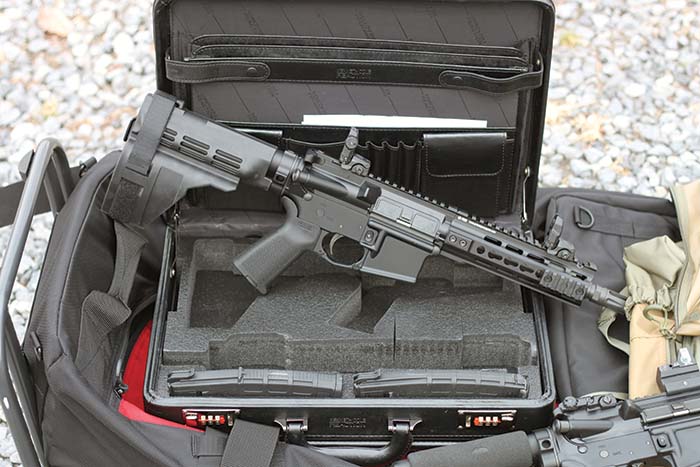PWS offers users the option of a Kenneth Cole customized briefcase for discrete carry of the Mk 107 AR pistol. The upper and lower receivers are securely held in cut out foam insert.
By Todd Burgreen
This review pertains to two PWS (Primary Weapons Systems) Mk 107 AR pistols – one with SIG Sauer SB15 stabilizing arm brace affixed to the buffer tube and the other without. It was decided to follow this dual path as each AR pistol offers a different method of deployment as the SIG brace is increasingly popular and buffer tube AR pistols continue to move off of dealer shelves. While the SB15 brace resembles a stock, it is not and the BATF has issued a compliance letter blessing its use on an AR pistol. The buffer tube only AR pistols have been in existence for some time now with their own various methods of most effective deployment established.
The PWS Mk 107 AR pistol features a 7.75 inch barrel and is a piston driven AR. The PWS Mk 107 uses a long stroke piston method of operation in lieu of either more typical AR methods such as direct impingement or short stroke piston. Significant differences are present in the PWS long stroke system compared to other operating methods. PWS product improvements address reliability and performance issues as well as reduced carrier tilt, cam pin wear and carrier bounce. Proponents of piston-driven ARs point to greater reliability in adverse conditions and less reliance on routine maintenance compared to direct impingement operating method. The increasing use of shorter barrels and suppressors for civilians, law enforcement, and military highlight another advantage of the piston-driven ARs; the ability to adjust the amount of gas siphoned to operate the action.
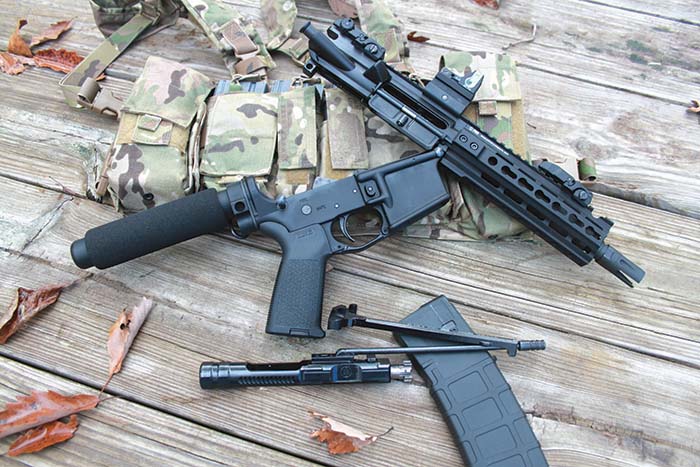
Currently, piston driven ARs enjoy a perception of better operating reliability in harsh environments, especially as barrel lengths shrink. Instinctually, the gas-piston ARs appeal to many by the very fact that hot gases and powder residue are not dumped into the action like the original direct impingement (DI) design. Anecdotal evidence of bolt carriers being handled soon after long strings of fire and merely wiped down compared to their DI cousins reinforces this. Do not take this as lampooning of the gas impingement ARs. The DI rifles are more robust than most give them credit for and sub-14 inch rifles are possible with attention to detail by the manufacturer in terms of gas port sizes and timing of the ejection process.
Within the piston-driven AR world there is a less well known debate happening between long-stroke and short-stroke piston-driven designs. For our purposes, long stroke is exemplified by the AK47 method of having an op rod connected to the bolt carrier whereas short stroke consists of a more complicated arrangement of tapped gas imparting force to an op rod that impacts another part of the mechanism that acts on the bolt carrier. The Primary Weapons Systems PWS Mk 1 series represents cutting edge long-stroke AR design. This is different than the original Stoner designed gas impingement design as well as the growing numbers of short-stroke piston ARs arriving on the market. A look at a PWS Mk 1 disassembled with the AK-like operating rod connected to the charging handle and bolt carrier leaves little doubt of the AK inspired PWS design. The PWS long stroke piston evolved out of early PWS short-stroke conversions by eyeing simplicity, fewer and hardier parts. PWS Mk 1 ARs require no tools needed to disassemble with maintenance requirements even less than other piston systems. The PWS Mk 1’s gas-piston system can be disassembled for maintenance without requiring the rifle’s handguards to be removed, unlike some of the short stroke ARs on the market. Proponents of the long stroke AR method argue that it does not have multiple parts banging into each other with the operating rod and bolt carrier group moving together under the impulse of a fired round and this contributes to minimizing carrier tilt and carrier bounce typically found on short stroke AR piston designs. Overall, the PWS long stroke is simpler in operation with fewer parts involved than the short stroke AR. Additionally, the parts that are used are larger and thus more than likely robust in the long term.
A large dwell chamber in front of piston’s head helps to smooth out recoil impulse. Further along this design motif is the forward canted gas tap directing gas from the barrel in a forward orientation into the dwell chamber versus the more typical horizontal or rearward angle. The forward cant also helps to minimize any carbon build up on the operating rod.
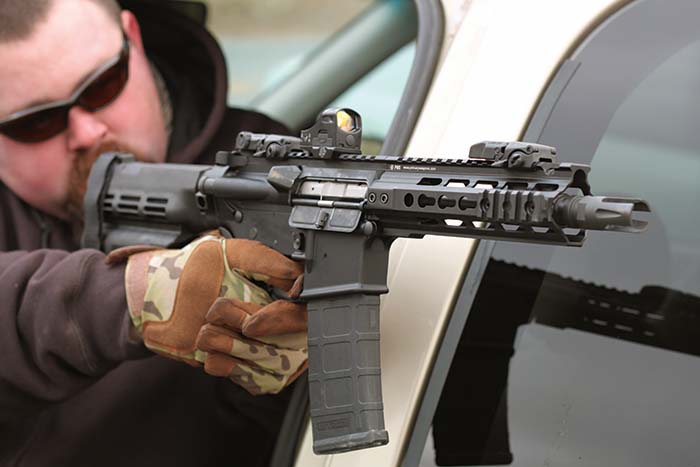
A recently added PWS feature for the Mk 107 is a VLTOR KeyMod 7-inch rail system. Short KeyMod sections of rail can be moved as desired to numerous positions around the hand guard, removed, or more sections added, depending upon the user’s preference. All of this keeps the overall rifle package lighter and more compact. PWS uses a forged upper receiver and equips the Mk 107 with Magpul MOE pistol grip. PWS has eliminated the typical AR castle nut method of attaching the carrier tube to the lower receiver via indexing screws instead. PWS has designed an enhanced buffer tube with an extended lip to eliminate carrier tilt adversely wearing on a buffer tube. Magpul flip up BUIS (Back Up Iron Sights) sights are fitted to the rifle’s top rail. A Magpul 30-round PMag arrives with the rifle. An extended BCM charging handle offers the user plenty of leverage to operate the Mk 107’s bolt group. Lastly, an ALG Defense QMS trigger is fitted into the forged lower receiver.
Suppressor use is increasingly popular both in the civilian and military/LE realm. As a result, PWS wanted to increase the Mk 1’s friendliness in regards to suppressor use. While the original Mk 1 was able to be suppressed by simply changing the buffer weight, this was hardly conducive to on-the-fly mission adaptability. The need for simple adjustment at the gas block was obvious with PWS responding. PWS’s desire to be suppressor friendly led them to adopting an adjustable gas block as well. The gas adjustment is very simple. There is a tool in the grip panel of the MOE grip. This tool inserts into the adjustment holes in the gas knob and you simply rotate it to the next position/detent until the desired setting is selected for your specific suppressor setup. An adverse condition setting is not needed as the PWS system is designed to operate with enough back pressure at all times no matter how dirty or fouled: that is something to be appreciated in a fighting rifle. There is a standard setting indicated by an “O”. Then there are three suppressed settings each distinctively marked as well and a takedown setting marked “X”. The knob can be turned in either direction and there is no “closed/single shot” setting.
It is best to view the 7.75 inch barreled PWS Mk 107 – either SBR rifle or AR pistol – through the lens of a PDW versus handgun or rifle. The 7.75 inch barrel produces approximately 2,100-2,300 fps velocities with the 5.56mm round while maintaining enough rail space for solid purchase and accessories as users see fit. The KeyMod hand guard facilitates better air flow around both the gas tube and barrel for more efficient cooling during long strings of fire. PWS points to the size similarity of the Mk 107 compared to the MP5 SMG – for many years the gold standard for military and LE entry teams. The Mk 107 firing the 5.56mm rifle round compared to the MP5 chambered in 9mm pistol round provides an all-around ballistic advantage. Even at 2,100 fps velocity, the Mk 107 will be effective out to 200 yards in terms of penetration and terminal ballistics. The key with the PWS Mk 107 is having a short barreled AR that works, and works at the same reliability level as longer barrel ARs. This is where the PWS long stroke piston comes into play.
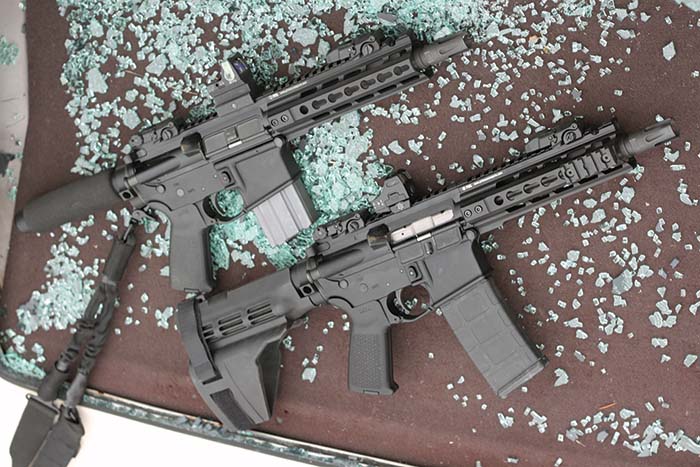
Most individuals struggle with the balancing of weapon carried versus discreteness. This is why typical pattern handguns are the prevalent choice of weapon carried. This is not because handguns are the most effective choice; just the easiest to have around at all times in most social settings. The PWS Mk 107 AR pistol changes this mantra with its firepower, increased terminal punch and adaptability for discrete carry. A weapon like the AR pistol has its own advantages in terms of handling, ease of concealability and increased portability that is hard to resist when compared to a rifle. For individuals that have no access to a NFA Class 3 Short Barrel Rifle (SBR), the AR pistol may well be the closest they can get to achieving rifle firepower in such a compact package.
One way of maximizing the AR pistol’s capabilities is as an “off body” weapon candidate thanks to its relative compactness and potential firepower. Here the pistol designation is important for anyone with a Concealed Carry Permit. Potential gear enhancers in this role would be the BLACKHAWK! Diversion Carry Board Pack and Rolling Load Out Bag. Another option is a Kenneth Cole customized leather briefcase available directly from PWS. The Kenneth Cole briefcase is custom fitted with padded insert where the PWS Mk 107 pistol is separated into upper and lower halves. The BLACKHAWK! Diversion bags and Kenneth Cole products offer “hide in plain” site utility with enhancements to accommodate a weapon and ancillary gear such as magazines.
A more traditional “bug out” role for the AR pistol is worthy of consideration as well. The Eberlestock Gunslinger II (G2) pack is a perfect candidate for a “bug out” bag, especially considering one’s weapon can also be stored in the pack with a magazine in place. It is possible to completely cover your rifle with the Eberlestock “butt cover” to keep away elements or prying eyes. Many frown on “off body” carry due to not always being attached to one’s weapon. Individuals will have to come to their own understanding of what is acceptable to them in this regard.
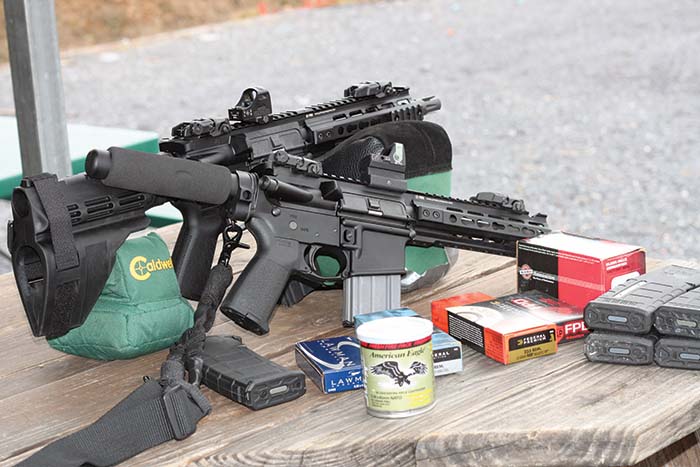
T&E of the two PWS Mk 107 AR pistols took place at Echo Valley Training Center (EVTC). Range T&E followed an established protocol of verifying sight zero of the flip down Magpul iron sights; the same was done with the affixed Trijicon RMR and Meopta Meosight red dots. A 50 yard zero was chosen considering the short barrel pistol configuration. After this was done evaluation commenced with a function test involving firing several magazines in rapid succession at various targets and vehicles that dot the range. While not unique, this is a good way to establish a baseline for reliability.
A compact weapon like the PWS Mk 107 AR pistol has its own advantages in terms of handling, ease of concealability and increased portability that is hard to resist. What does the AR pistol offer in terms of real utility in its pistol form? The answer here is nebulous based on user expectations and method of use. For many, the AR pistol, while enticing due to firepower potential, lacks much in terms of accuracy past normal handgun ranges with the added negative of weighing over 6 pounds. While definitely categorized as a fun firearm, the AR in its pistol form is somewhat limited in its effectiveness when compared to a rifle formatted AR. Or is it if a user can adapt to it?
PWS has addressed this by offering their Mk 107 AR pistol with the SIG Sauer SB15 Stabilizing Brace mounted around the buffer tube extension. Ostensibly, the SB15 brace secures the AR pistol to the shooter’s forearm. The increased leverage allows for greater support versus holding onto the Mk 107 AR pistol in a traditional handgun grip. However, better methods are available for a SIG braced equipped AR as well as typical buffer tube AR pistol. For example, the buffer tube is floated/placed on the cheek providing three points of contact for more stability and thus accuracy.
The SAS sling method (aka Israeli method in some circles) utilizes a looped sling attached to the rear of the receiver. The loop goes around your neck and over your shoulder. You push the weapon forward with your strong hand on the pistol grip and your weak side hand on the fore end. The sling is sized to keep the rear of the receiver at the same distance from your nose as a standard stock. This technique gives you three points of contact – rear grip, fore grip and sling. Anecdotes make mention that the SAS arrived at the sling method for CQB actions due to not being able to achieve a cheekweld on their H&K MP5 stocks while wearing a gas mask. The sling method has faded in popularity with Tier One units as weapons and methods have evolved. However, its use is still relevant for anyone contemplating serious use of an AR pistol. In short, the weapon is “punched” out creating tension on the sling that serves as a point of contact between the user and weapon. While not optimum and not nearly as effective as a true stock cheekweld, the sling method proved better than merely attempting to hold the PWS Mk 107 as in the pistol method.
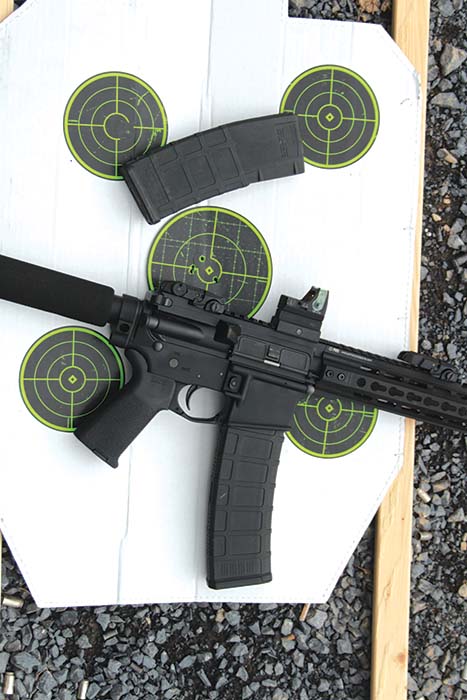
The big question is what purpose does the AR pistol serve? It is certainly not the most practical handgun in the traditional sense considering size and weight. However, for jurisdictions that do not allow SBR class of weapons the AR pistol is a valid option. Does the stabilizing brace, two handed hold, or sling method increase the AR pistol’s utility and effectiveness? The sling method used with PWS Mk 107 is an improvement over just pushing out like a handgun. This still does not turn the AR pistol into a serious first choice for a personal defense firearm compared to other tools available. Attaching the SB15 to your forearm definitely increases leverage when operated with only one hand. However, the SB15 equipped PWS Mk 107, once affixed to the forearm, makes natural flow and tactical movement problematic. With that said, no one is advocating this format of use for a martial role. A floating cheek-weld is much more realistic approach.
The fact the AR pistol is classified legally as a handgun offers users who have a concealed carry license a certain amount of flexibility compared to a true rifle or NFA classified weapon. We are talking about carry options based on handgun label. Here is where the AR pistol’s true asset in one’s inventory becomes evident, especially when combined with exploration of how best to deploy it in imaginative ways beyond the typical two handed pistol grip.
SPECIFICATIONS
PWS Mk 107 AR pistol
Barrel length: 7.75 inches
Caliber: 5.56mm NATO with .223 Wylde chamber
Weight: 5 lbs.
Length: 23.75 inches
MSRP: $1,949
Sites of Interest
Primary Weapons Systems
www.primaryweapons.com
Meopta U.S.A., Inc.
www.meopta.com
Trijicon Inc.
www.trijicon.com
Echo Valley Training Center
www.echovalleytrainingcenter.com
| This article first appeared in Small Arms Review V19N5 (June 2015) |



